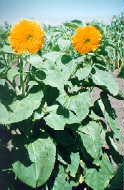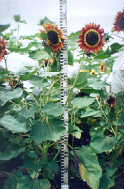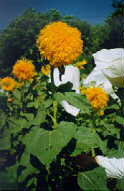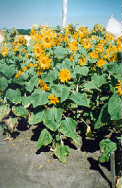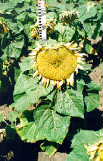 |
Studies of Hybrids Between Cultivated Sunflower and Wild Perennial Helianthus Species |
|
 |
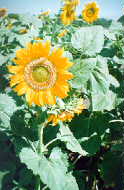
|
Summary Interspecific hybrids between Helianthus annuus and 19 wild perennial sunflower species have been produced. No segregation by all analysed characters was found in F2-F4 generations of different cross combinations. Phenotypes of non-segregating progenies were similar for different interspecific hybrids. Introduction Wild perennial sunflower species possess some valuable agronomic characteristics, in particular resistance to pathogens (Seiler, 1988). These characters may be used for genetic improvement of the cultivated sunflower. Therefore, studies of crossability of the cultivated sunflower and wild perennial species are of special interest. Materials and Methods Experiments were carried out at the Kuban Experiment Station located in Southern Russia in the Krasnodar Territory. Crosses and analyses of F1-F4 hybrids were performed in 1990 through 1994. The cultivated sunflower CMS lines VIR 151 and HA 234 were used as maternal forms. Twenty-two wild perennial species (according to classification of Heiser, 1969) were used as pollen parents.
Results and Discussion
Nineteen out of 22 wild perennial species were compatible in crosses with H.annuus. All F1 plants were annual and similar to the cultivated sunflower by morphological characters. They were distinguishable from the maternal CMS line. The hybrids had characters derived from wild forms, namely strong pubescence of the stem, anthocyanin colour and various types of branching (upper, lower and throughout the stem branching); some plants had branches of the first and second orders. In F1, segregation by these characters and also by plant height, vegetation period and fertility rate was observed. These data indicate that the plants are true interspecific hybrids, but not apomictic progenies of the maternal CMS line.
In the subsequent hybrid generations F2, F3 and F4 some cross combination progenies showed segregation by the analyzed characters while others were practically homogeneous. No segregation was observed in F2-F4 hybrids of H.annuus x H.floridanus and H.annuus x H.trachelifolius. Certain progenies of interspecific hybrids H.annuus x H.giganteus, H.annuus x H.maximiliani, H.annuus x H.californicus, H.annuus x H.occidentalis, H.annuus x H.rigidus, H.annuus x H.tuberosus revealed segregation in F2-F4, while the others did not. Nonsegregating progenies of different interspecific hybrids had identical phenotypes, namely intensive pubescence of the stem, anthocyanin colour of the stem and petioles, small heart-shaped leaves branching throughout the stem, the main head of 10 cm in diameter with 4 to 7 small heads around it.
In F2, F3 and F4 generations of hybrids H.annuus x H.angustifolius, and H.annuus x H.grosseserratus segregation as in F1 was revealed. Hybrids H.annuus x H.maximiliani, H.annuus x H.californicus, and H.annuus x H.occidentalis showed no segregation if F2 and F3. However, progenies of various plants differed significantly. At the same time, the derived progenies of each individual plant were morphologically homogeneous.
|
References
- Georgieva-Todorova J., 1988. Results from the interspecific hybridization in the genus Helianthus L. - Proc.of the symposium on interspecific hybridization. Sofia, pp.96-105.
- Heiser Ch., Smith D., Clevenger S. and Martin W., 1969. The North American sunflower (Helianthus). - Mem.Torrey Bot.Club. V.22, No.3, p.218.
- Kostoff D., 1939. Autosynthesis and structure hybridity F1 - hybrid H.tuberosus L. x H.annuus and their sequences. - Genetica, Deel 11, Aft.5-6, pp.285-300.
- Seiler G., 1988. The genus Helianthus as a source of genetic variability for cultivated sunflower. - Proc. 12th Intern. Sunflower Conference, Novi Sad, pp.17-54.
- Christov M., 1990. Investigation of wild Helianthus species aimed at their use in sunflower breeding (Bulg.) - Abstract of Ph.D. Thesis. Sofia, 34 p.
| Studies of Hybrids Between Cultivated Sunflower and Wild Perennial Helianthus Species |  |
